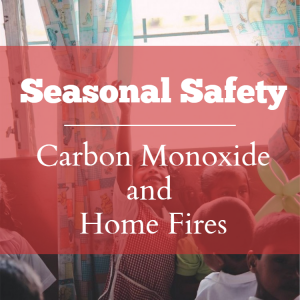Seasonal Safety Tips: Carbon Monoxide and Home Fires
 As a homeowner, each season of the year comes with its own hazards and responsibilities. In the cooler months, staying on top of dangers carbon monoxide and home fires should be at the top of your list, especially if many of your appliances are fuel-based as opposed to electric.
As a homeowner, each season of the year comes with its own hazards and responsibilities. In the cooler months, staying on top of dangers carbon monoxide and home fires should be at the top of your list, especially if many of your appliances are fuel-based as opposed to electric.
Whether you have a fireplace, a gas water heater, a gas oven, or all of the above and more, it’s important to make sure you and your family are aware of the dangers and how to prevent them.
Carbon Monoxide
Carbon monoxide is the ultimate invisible killer. You can’t see, taste, or smell it, so it’s very difficult to know if there are high levels present in your home unless you have a carbon monoxide detector. We recommend installing one on every level of your home.
The symptoms of carbon monoxide poisoning are similar to flu symptoms, which include a headache, dizziness,fatigue, shortness of breath, and nausea.
Carbon monoxide in the home is usually produced on by one of the following:
- Improper operation of appliances
- Running an internal combustion engine
- Burning carbon-based fuels in insufficiently ventilated areas
High levels of carbon monoxide become present when fuels are burned incompletely, running internal combustion engines in closed spaces, or when appliances are defective/improperly installed/improperly maintained. Carbon monoxide can also become present if an appliance venting system or a chimney becomes blocked.
Carbon Monoxide Safety Prevention Tips
- Install a carbon monoxide detector on every level of your home
- Never run an internal combustion engine (car, lawn mower, generator, etc.) in a closed space
- Have a regular maintenance schedule for all of your appliances
- Clean your chimney regularly to ensure there are no blockages
Immediate Action Tips
If you suspect that there are high levels of carbon monoxide in your home, act IMMEDIATELY.
- Get everyone out of the building and call 911
- If safe, open all windows and turn off appliances you suspect are producing carbon monoxide
- Call a qualified service technician to check carbon monoxide levels and find the source of the excessive carbon monoxide
Fire Safety
According to the American Red Cross, if a fire starts in your home you only have two minutes to escape. Not to mention the fact that half of fire-related deaths result from fires reported between the hours of 11 pm and 7 am, when most everyone is sleeping. While fires are certainly not invisible, they can cause a lot of damage very quickly.
Fire Safety Prevention Tips
- Install smoke alarms on every level of your home both types (ionization and photoelectric)
- Test all smoke alarms once a month, replace batteries as needed
- Be sure to get your chimney cleaned regularly to prevent buildup and blockage, particularly in the cooler seasons
- Make sure you get all of your home appliances checked for malfunctions
- Develop a fire safety plan with your family and practice it twice a year
- Know how to use your fire extinguisher
Immediate Action Tips
If a fire occurs in your home, get out immediately and call for help. Do NOT go back inside the house.
- If you smell the smoke before you see the fire, cover your face
- Get down low to avoid smoke inhalation
- Do not open doors if you see smoke coming from underneath them
- Put your hand to a closed door to see if it is hot before trying to exit
- If you are on fire: stop, drop, roll and cover your face while doing so
- Do not attempt to put out the fire with the wrong method (i.e. do not try to put out an electrical fire with water, you could electrocute yourself, etc.) Learn more about the different types of fires here.
We cannot stress enough the importance of routine maintenance of all of your fuel burning appliances. Preventing dangers associated with carbon monoxide and home fires starts with a good maintenance schedule.We recommend servicing your appliances annually. If you’re interested in more safety tips, check out our modules. Or, if you’re ready to schedule a service, head over to our Contact Us page to get connected with your closest G&B office.

